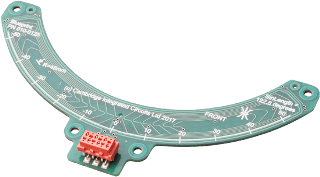Jun 23 2017
New arc position sensors launched by CambridgeIC are capable of measuring the angle of a rotating target relative to an arc shaped, fixed sensor built from a PCB.
 Credit: CambridgeIC
Credit: CambridgeIC
Sensors are precise, robust and can function in harsh environments. They use resonant inductive position sensing technology to measure absolute angle without physical contact. This helps in delivering wear-free operation and highlights the possibility of installing sensors without calibration or alignment.
The Arc Position Sensors from CambridgeIC are specifically ideal for applications in which customers need to insert a position sensor inside their product, and are looking out for a simpler mechanical design. Typical examples include measurement of valve angle, exercise equipment, suspension level, surveillance camera tilt, antenna elevation and heliostat angle for solar energy collection.
The new arc position sensor range comprises of parts with sensor radius of 100 mm, 68 mm, 48 mm, 36 mm, 30 mm and 25 mm. These parts work with CambridgeIC’s Standard Target positioned either towards the outside or the inside of the sensor arc.
Customers will have sensors built to CambridgeIC’s designs at their usual PCB Manufacturer in most production applications. This explains the fact that the customer’s mechanical design team will be able to adapt the PCB design in order to obtain the best possible integration with their product. For instance, they can customize connector, attachment features and shape, and at times even add processing circuitry to the same physical PCB.
Precise measurements are delivered to the host product’s processor by wiring sensors to a CambridgeIC processor chip, for example the CAM204.
We believe this is a world first: a range of truly non-contacting, embeddable sensors that measure positon along an arc. They avoid the mechanical complexity that comes from adapting traditional linear and rotary sensors for the task.
David Ely, Founder and Director of CambridgeIC
Samples of the new arc sensors, development boards and other tools for prototyping and evaluation are currently available.